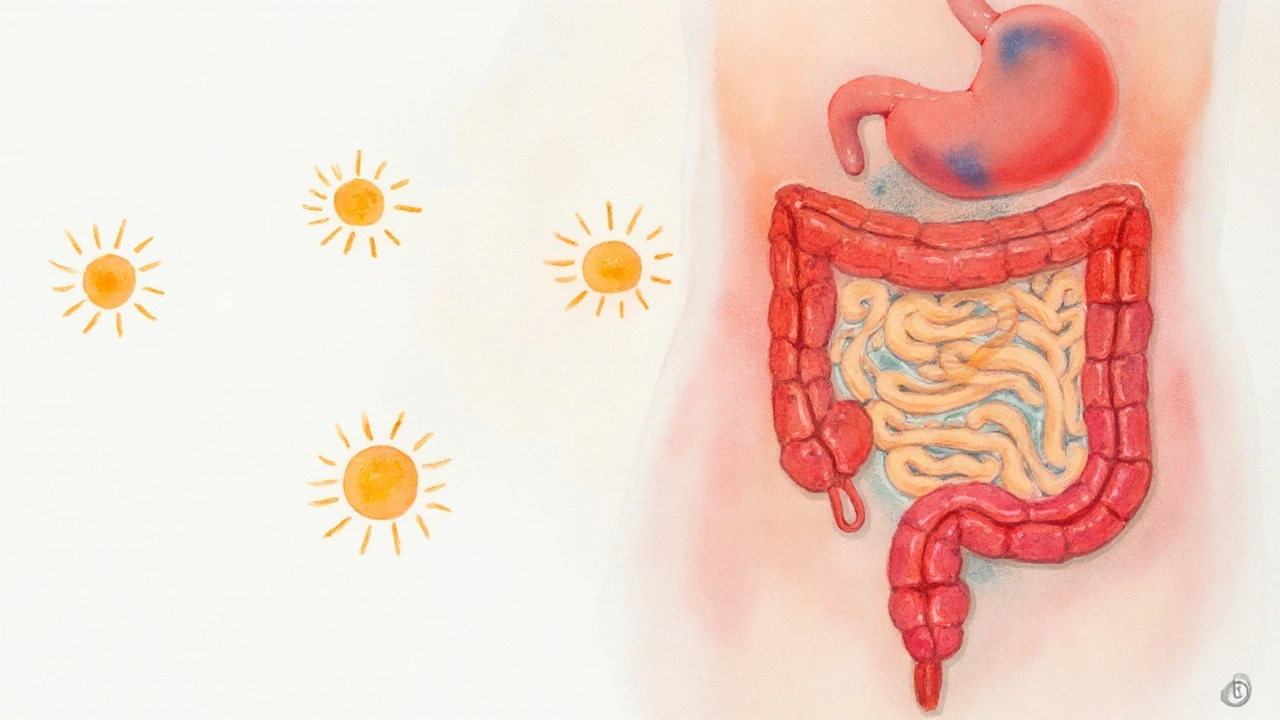Key Takeaways
- Vitamin D deficiency is linked to higher flare rates and complications in IBD.
- Serum 25‑hydroxyvitamin D below 20ng/mL is considered deficient for most patients.
- Sun exposure, diet, and targeted supplementation can raise levels safely.
- Genetic variations in the vitamin D receptor (VDR) affect individual response.
- Regular monitoring of vitamin D status should become part of IBD management.
Vitamin D deficiency is a condition marked by serum 25‑hydroxyvitamin D (25(OH)D) concentrations below 20ng/mL, leading to impaired calcium absorption, weakened bone health, and altered immune regulation.
People with inflammatory bowel disease (IBD) often report persistent fatigue, bone loss, and frequent flare‑ups. A growing body of research suggests that low vitamin D isn’t just a side effect-it may actively drive the disease process.
Inflammatory Bowel Disease is a chronic, immune‑mediated disorder of the gastrointestinal tract that includes Crohn’s disease and ulcerative colitis. These two conditions share a common thread: a dysregulated immune response that attacks the gut lining.
Understanding Vitamin D Deficiency
The most reliable marker of vitamin D status is Serum 25‑hydroxyvitamin D, the circulating form measured in blood tests. Levels are classified as follows:
- Deficient: < 20ng/mL (or < 50nmol/L)
- Insufficient: 20-29ng/mL
- Sufficient: 30-60ng/mL
- Potentially toxic: > 100ng/mL
Factors that drive deficiency include limited sun exposure, high latitudes (like NewZealand’s winter), darker skin, obesity, and malabsorption - all of which are common in IBD patients.
What Drives Inflammatory Bowel Disease?
IBD arises when the gut microbiome the community of bacteria, fungi, and viruses living in the intestines loses its balance, allowing harmful microbes to trigger inflammation. The gut‑associated lymphoid tissue (GALT) then overreacts, releasing cytokines that damage the lining.
Key players in this cascade are:
- Th17 cells that produce IL‑17
- Regulatory T cells (Tregs) that normally keep the response in check
- Memory B cells that create auto‑antibodies
When vitamin D levels dip, the ability of Tregs to suppress inflammation fades, tilting the balance toward disease activity.
How Vitamin D Influences the Gut Immune System
The hormone‑like active form, 1,25‑dihydroxyvitamin D, binds to the vitamin D receptor (VDR), a nuclear transcription factor found on immune cells, intestinal epithelial cells, and even gut microbes. This interaction triggers three critical actions:
- Up‑regulation of antimicrobial peptides (cathelicidin, defensins) that keep harmful bacteria at bay.
- Promotion of Treg differentiation, which dampens pro‑inflammatory cytokines.
- Modulation of tight‑junction proteins, strengthening the gut barrier and preventing “leaky gut”.
Genetic variations in the VDR gene (e.g., FokI, BsmI polymorphisms) can blunt these benefits, explaining why some patients remain deficient despite adequate intake.

Evidence Linking Deficiency to IBD Activity
Multiple cohort studies and meta‑analyses reveal a consistent pattern:
- Adults with Crohn’s disease who are vitamin D deficient have a 1.8‑fold higher risk of hospitalization.
- Pediatric IBD cohorts show that each 10ng/mL increase in 25(OH)D reduces the odds of a flare by about 12%.
- Randomized trials of high‑dose vitamin D (2,000-4,000IU/day) report modest but significant reductions in CRP and fecal calprotectin levels.
Conversely, patients with sufficient levels often need lower doses of corticosteroids and have fewer surgery‑related complications.
| Outcome | Deficient (<20ng/mL) | Sufficient (≥30ng/mL) |
|---|---|---|
| Annual flare rate | 1.6-2.2 per year | 0.8-1.2 per year |
| Hospital admissions | 45% higher | Baseline |
| Need for steroids | 30% more courses | Baseline |
| Bone mineral density loss | Average -2.5%/yr | Average -0.8%/yr |
Practical Steps to Optimize Vitamin D for IBD
Because deficiency is both a cause and consequence of inflammation, a proactive approach works best.
1. Test and Track
Ask your gastroenterologist to order a serum 25‑hydroxyvitamin D test at least twice a year - once in summer, once in winter. Record the numbers and aim for a target of 40-60ng/mL. This range maximizes immune benefits while staying safely below toxicity.
2. Sun Smart Strategies
In Wellington, midsummer UV‑B peaks around 10am-2pm. Expose face, forearms, and lower legs for 10-15minutes, three times a week, without sunscreen (but avoid burn). During winter, supplement becomes essential because UV‑B intensity drops below the threshold for vitamin D synthesis.
3. Dietary Sources
Include natural and fortified foods:
- Fatty fish - salmon, mackerel (≈400IU per 100g)
- Mushrooms exposed to UV light (≈300IU per 100g)
- Fortified dairy or plant milks (≈100IU per cup)
- Egg yolks (≈40IU per egg)
Even with a well‑balanced diet, most IBD patients need supplementation because malabsorption limits uptake.
4. Supplementation Protocol
A typical regimen looks like this:
- Loading phase: 4,000IU daily for 8weeks if <20ng/mL.
- Maintenance phase: 1,000-2,000IU daily, adjusted based on repeat labs.
- Choose cholecalciferol (vitaminD3) - it’s more potent than ergocalciferol (D2).
Patients on corticosteroids may require up to 5,000IU daily to counteract steroid‑induced vitamin D catabolism.
5. Address VDR Polymorphisms
If genetic testing reveals a low‑function VDR variant, clinicians often raise the target serum level to 50-70ng/mL and consider adding calcium‑lactate to improve intestinal absorption.
Related Concepts and Wider Context
The vitamin‑D‑IBD link sits within a broader ecosystem of nutrition‑driven gut health. Other entities that intersect include:
- calcium absorption - closely tied to vitamin D status and bone health.
- autoimmune response - IBD is a classic example where diet modulates immune tolerance.
- seasonal variation - flare frequency often climbs in winter when sunlight wanes.
- biologic therapy - agents like anti‑TNF work better when patients have adequate vitamin D.
Exploring these connections can guide a holistic management plan that goes beyond medication alone.
Next Steps for Patients and Providers
For anyone living with IBD, treating vitamin D deficiency isn’t a cosmetic tweak; it’s a disease‑modifying strategy.
- Schedule a blood draw for 25(OH)D before your next gastro appointment.
- Discuss a personalized sun‑exposure plan with your dermatologist.
- Start a low‑dose vitaminD3 supplement now; adjust after labs.
- Track flare symptoms, medication changes, and vitamin D levels in a health journal.
- Review the journal with your care team every 3-6months to fine‑tune dosing.
Taking these steps early can lessen reliance on steroids, improve bone density, and keep the gut calmer.

Frequently Asked Questions
How low does my vitamin D need to be before it affects my IBD?
Most clinicians consider a serum 25‑hydroxyvitamin D level below 20ng/mL (50nmol/L) as deficient and linked to higher flare rates. Levels between 20-29ng/mL are insufficient and still carry increased risk.
Can I rely on sunlight alone in NewZealand?
During summer, a short midday sun exposure (10‑15minutes) can generate enough vitaminD for many people. In winter, UV‑B intensity drops dramatically, so supplements become essential for most IBD patients.
Is there a risk of taking too much vitaminD?
Toxicity is rare and usually occurs only when daily doses exceed 10,000IU for several months. Keeping the target serum level below 100ng/mL avoids hypercalcemia and kidney stones.
Do genetic tests for VDR matter?
Testing can identify patients who need higher target levels. If a low‑function VDR polymorphism is present, clinicians often aim for 50‑70ng/mL and may increase supplement doses accordingly.
How often should I retest my vitaminD level?
Testing twice a year-once in summer, once in winter-captures seasonal swings and helps fine‑tune dosing. More frequent checks may be needed after a dosage change or during a flare.

man i never realized how much my gut issues were tied to not getting enough sun. i live in seattle and basically turn into a vampire during winter. started taking 2000 IU daily last year and my flares dropped off like magic. not saying it's a cure, but it's like my body finally got the memo to chill out.
also, my doc never mentioned checking my levels until i brought it up. why isn't this standard? everyone with IBD should get tested like clockwork.
While the association between vitamin D deficiency and increased disease activity in inflammatory bowel disease is well-documented in the literature, it remains prudent to interpret these findings within the context of multifactorial pathophysiology. Supplementation should be considered adjunctive, not curative, and individualized based on baseline serum concentrations and genetic polymorphisms.
okay but let’s be real - the VDR gene stuff is wild. i have the FokI ff variant and my levels are always low even when i’m taking 5k IU and sitting in the sun like a lizard. it’s not that my body doesn’t absorb it, it’s that the receptor is basically broken. i’ve read papers where they say ‘just take more’ but no - if your receptor’s glitchy, more vitamin D just sits there like a useless key in a lock that’s rusted shut.
and honestly? the microbiome connection is the real MVP. vitamin D doesn’t just tweak immunity - it talks to the bacteria in your gut like a peacekeeper. some strains actually metabolize it. imagine that. your gut bugs are literally using your supplement to calm down your immune system. that’s not science, that’s a symphony.
also, why do we still treat IBD like it’s just ‘inflammation’? it’s a full-system breakdown. your skin, your bones, your mood - all connected. vitamin D isn’t a bandaid. it’s the whole damn orchestra tuning up.
^^^ this. i had a flare last winter and my doc just upped my mesalamine. i was like ‘what about my vitamin D?’ turned out i was at 14 ng/mL. started supplementing and within 3 weeks my energy came back. no magic, just biology.
also, my mom’s from India and she always said ‘go outside, sun is good.’ turns out she was right. maybe we should’ve listened more.
It is imperative to underscore that while observational data demonstrate a correlation between serum 25-hydroxyvitamin D concentrations and clinical outcomes in inflammatory bowel disease, causality has not been definitively established. Prospective, double-blind, placebo-controlled trials with adequate power remain necessary before routine supplementation can be universally recommended as a standard of care.